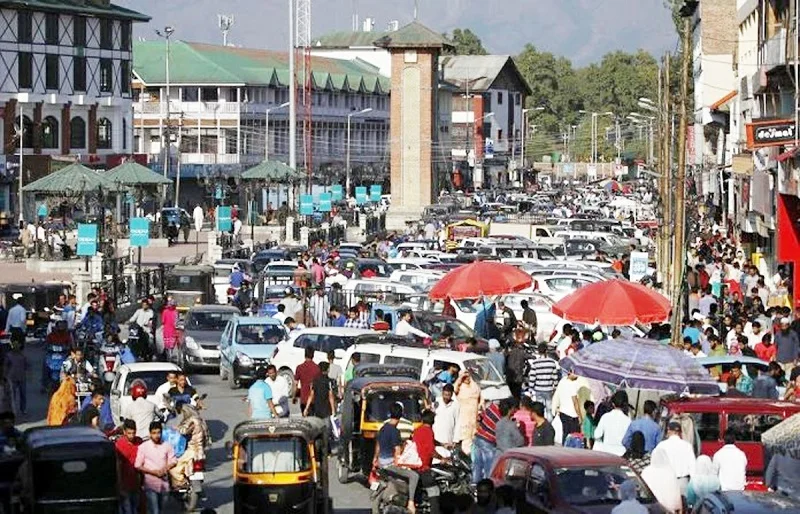
J&K Economy from the rear view-Part IV
This is the fourth piece in a Four-part series that outlines the processes of change in J&K Economy since 1996-97
THE mainstream debate on economic development is often confined to quantitative aspects depicted by hard numbers like Gross Domestic Product, per capita incomes, tax growth, investment rate, credit expansion, exchange rates and inflation. The obsession with these numbers often overshadows the essential and importantly more meaningful dimensions of human progress. The problem with selective statistical methods like averages is that it blurs out some essential insights. Take for example the growth in per capita income. By averaging out the wide range incomes with population size, it totally conceals the dangerous rise of wealth inequality. It was in this backdrop that the United Nations introduced the Human Development Index (HDI) as a more relevant measure of effectiveness of economic policies.
As per United Nations Development Programme (UNDP’s) official website, the HDI has been created to emphasize that people and their capabilities should be the ultimate criteria for assessing the development of a country, not economic growth alone. The HDI, as per UNDP, can also be used to question national policy choices, asking how two countries with the same level of per capita income can end up with different human development outcomes. These contrasts, as per UNDP, can stimulate debate about government policy priorities. The HDI captures achievement in key dimensions of human development i.e. a long and healthy life, education levels and standard of living by factoring incomes levels. The last data available for HDI is that of 2018. J&K’s HDI in that year stood at 0.68 bettering all India average of 0.647. Pertinently, industrially developed states like Gujarat and Andhra Pradesh, with huge economic output and substantially higher per capita incomes than J&K, rank much lower with an HDI of 0.672 and 0.65 respectively.
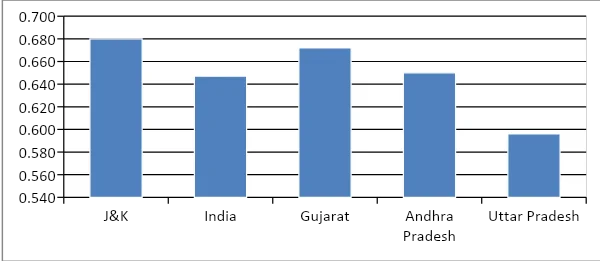
So far this four part series on the last three decades of J&K’s economy has been focusing on the hard data points of macro economy including economic output in terms of GDP, per capita incomes, tax & debt trajectories, movement in savings, credit expansion and loan defaults. This fourth and final piece of the series shall outline the changes in J&K’s socio-economic indicators like literacy, life expectancy, infant mortality rate, poverty, and employment. These qualitative indicators can provide key insights about the progressive changes in the crucial variables which actually determine the well-being of the people.
Literacy:
It’s an established fact that if there is anything that can unleash the potential of a community and amplify its ability to create value in the most efficient ways, it’s the investment on providing quality education to its people. Although “literacy” is a very basic measure of a much wider term “education”, however, its performance does provide an insight about the progress or lack of it in this essential segment. Data available from the 1981 census shows that J&K’s literacy percentage at that point in time was around 30.64% much behind the all India average level of 43.57%. With growing public consciousness towards education as a means for securing stable Govt. jobs in the region, there has been a gradual improvement in this very essential socio-economic parameter. After two decades, the 2001 census data recorded J&K’s literacy levels jumping to 55.52%. All India percentage for the same period was still ahead at 65.38%. As per 2011 census, J&K’s literacy levels crossed 67% for the first time compared to all India level of 74.04%. The latest data for 2020 shows J&K’s literacy rates reaching an impressive 77.30 %, almost touching the national figure of 77.70%.

Life Expectancy:
Life expectancy as a socio economic indicator reflects, among other things, improvements in nutrition, health and, above all, a decrease in mortality. It also allows us to extrapolate at a glance the living conditions of populations in general. J&K’s average life expectancy has always remained higher than the national average. Compared to a national average of only 49.70 years, J&K’s life expectancy was way ahead at 56.1 years during the 1970-75 period. In sync with the global improvements in healthcare, nutrition and other ease of living parameters, this indicator has shown a remarkable growth in J&K as well. 2013-17 data shows J&K’s average life expectancy at birth crossing 74 years. The national average has also improved to 69 years, but continues to lag behind J&K by almost a constant margin.
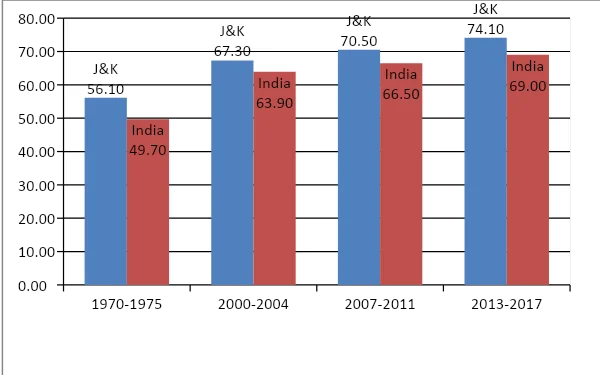
Poverty
Besides other things, one of the major yardsticks of a region’s economic performance is the percentage of people that have been alleviated from the trap of abject poverty. Although the percentage of people living below poverty line in J&K is far less compared to all India levels, however, contrary to the continuously improving national ratio, J&K’s graph has started showing signs of worry. Post 2009-10, the poverty levels have again started rising in J&K. While J&K had shown remarkable progress in reduction of poverty from the early 90’s to 2010’s, however, there has been no further progress in this very significant socio-economic indicator. Very recent surveys on J&K’s poverty are not available, but indirect data points like consumption sketch a dangerously escalating picture of poverty in J&K.

Infant Mortality Rate: In his widely popular book “Factfulness”, author Hans Rosling says the reason he is obsessed with performance of Infant Mortality Rate (IMR), as a socio-economic indicator, is that it measures the temperature of the whole society. Children are vulnerable and there are many things that can impact their mortality like infection, poor nutrition, violence, condition of primary health care, access to safe drinking water, mothers’ education, sanitation etc. In general it is a concentrated indicator of the quality of the whole society.
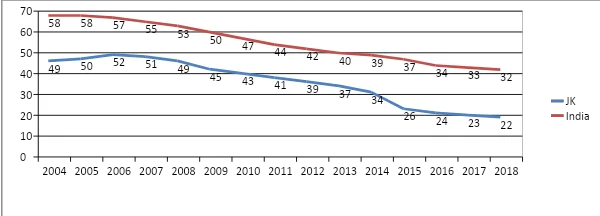
Data available from 2004 to 2018 shows a consistent improvement in J&K’s IMR. From a high of 49 deaths per every 1000 children born in 2004 to 22 in 2018, J&K has consistently scored better than the all India average. The national average for the same time frame has come down from a whopping 58 to 32. Madhya Pradesh at 48 IMR as on 2018 continues to be the worst while Nagaland at an impressive IMR of 4 enjoys the top slot. To put things into perspective J&K’s IMR at 22 is not just better than all India average (32) but better than 79 other countries including Bangladesh (31), Pakistan (67), Afghanistan (60.3), Nepal (31) & Myanmar (45). China and Sri Lanka on the other hand have an impressive IMR of 8 and 7 only.
Employment: Another important socio-economic factor which depicts the efficiency of the economy in creating viable jobs for its people is the employment rate. Irrespective of the growth numbers, if an economy is not creating sufficient income generating work for its workforce, there is a possibility of catalyzing poverty, worsening inequality and stimulating other harmful consequences on the human development.
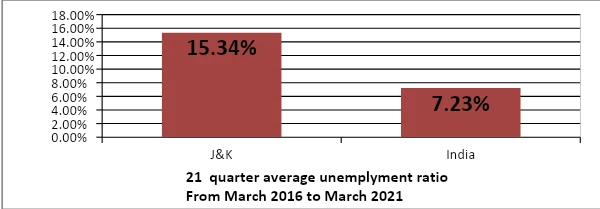
During 1950’s, over 85% of J&K’s population was engaged in agriculture. Over a period of time the dependence on agriculture as a primary source of employment has been replaced by the exponentially growing services sector and to some extent by the manufacturing and construction sectors. J&K has a consumption-driven economy with 23% of its current 44 lakh labor force deriving its livelihood from the trading sector and another 7% from the transport sector. While the UT has a comparatively small manufacturing sector, it does provide employment to around 3.5% of the working population. Handicrafts sector on the other hand provides income to more than three lakh artisans (7% of the workforce). More than 10% of the labor force work as government employees. The remaining working population is mostly absorbed by the agriculture sector with dismal support from a very limited number of extension counters of the corporate sector.
Unfortunately, a sizable portion of this 44 lakh workforce often finds it difficult to get any paid work. The percentage of such workers is what is indicated by the unemployment ratio. During the last 21 quarters i.e. from March 2016 to March 2021, J&K’s average unemployment rate has hovered above 15% while as the average all India unemployment ratio for the same period has remained only around 7%.
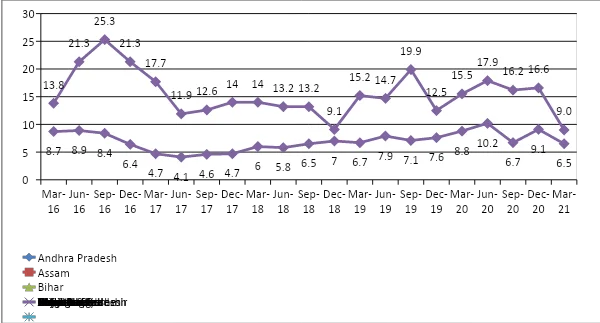
J&K’s last three decades have been marred with unprecedented political turmoil leading to over 3000 days of documented shutdown. Despite failing to catch up with the all India growth story post 1991 liberalization and lagging in almost all macro-economic variables, the paradoxical performance of socio-economic variables in J&K is a riddle worth studying. Barring employment, J&K’s performance in HDI, poverty, literacy, life expectancy and infant mortality rate shows a healthy pattern. Some seeds of the irony can be traced back to the disruption caused in the categorization of economic classes in 1950, when land was distributed evenly among peasants and landlords blurred class lines. This iconic decision resulted in an economically homogeneous society with majority of the people lying somewhere in the middle of the income bell curve. Land ownership has been a great leveler and this is why even today after almost seven decades, the below poverty ratio in J&K is far better than the national average. Besides this, the vibrant culture of collectively operated charity institutions has taken a deep and vital role in creating a people owned and operated social security net for the downtrodden and destitute. That’s why dying due to starvation or witnessing an old age home is still an alien concept in this region. Moreover, the sustained shutdowns and tremendous difficulty to secure stable livelihood has created an increased social consciousness towards education. The fast improving numbers in literacy compliment this assumption. One can’t help but wonder if J&K has managed to not just survive but surprisingly outperform in many socio-economic factors despite living through a consistent vortex of political unrest. The level of economic emancipation in normal scenarios would have been at a different level altogether.
(Data has been taken from Reserve Bank of India website, various economic surveys and state budgets. In case of conflicting data points, RBI’s data has been given preference)
Views expressed in the article are the author’s own and do not necessarily represent the editorial stance of Kashmir Observer
Follow this link to join our WhatsApp group: Join Now
Be Part of Quality Journalism |
Quality journalism takes a lot of time, money and hard work to produce and despite all the hardships we still do it. Our reporters and editors are working overtime in Kashmir and beyond to cover what you care about, break big stories, and expose injustices that can change lives. Today more people are reading Kashmir Observer than ever, but only a handful are paying while advertising revenues are falling fast. |
| ACT NOW |
| MONTHLY | Rs 100 | |
| YEARLY | Rs 1000 | |
| LIFETIME | Rs 10000 | |











